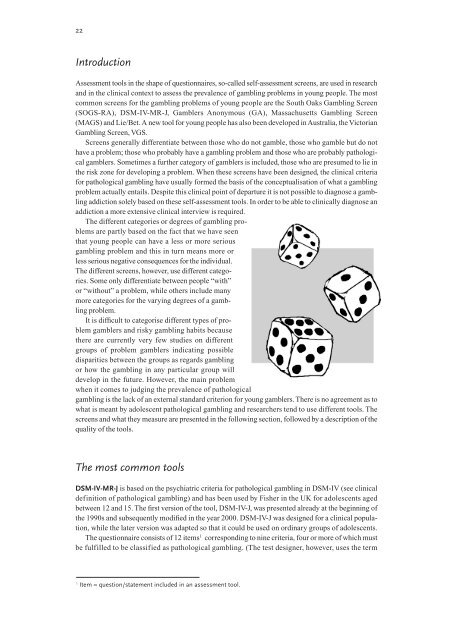Gambling Among Young People, 837 kB
Gambling Among Young People, 837 kB
Gambling Among Young People, 837 kB
You also want an ePaper? Increase the reach of your titles
YUMPU automatically turns print PDFs into web optimized ePapers that Google loves.
22<br />
Introduction<br />
Assessment tools in the shape of questionnaires, so-called self-assessment screens, are used in research<br />
and in the clinical context to assess the prevalence of gambling problems in young people. The most<br />
common screens for the gambling problems of young people are the South Oaks <strong>Gambling</strong> Screen<br />
(SOGS-RA), DSM-IV-MR-J, Gamblers Anonymous (GA), Massachusetts <strong>Gambling</strong> Screen<br />
(MAGS) and Lie/Bet. A new tool for young people has also been developed in Australia, the Victorian<br />
<strong>Gambling</strong> Screen, VGS.<br />
Screens generally differentiate between those who do not gamble, those who gamble but do not<br />
have a problem; those who probably have a gambling problem and those who are probably pathological<br />
gamblers. Sometimes a further category of gamblers is included, those who are presumed to lie in<br />
the risk zone for developing a problem. When these screens have been designed, the clinical criteria<br />
for pathological gambling have usually formed the basis of the conceptualisation of what a gambling<br />
problem actually entails. Despite this clinical point of departure it is not possible to diagnose a gambling<br />
addiction solely based on these self-assessment tools. In order to be able to clinically diagnose an<br />
addiction a more extensive clinical interview is required.<br />
The different categories or degrees of gambling problems<br />
are partly based on the fact that we have seen<br />
that young people can have a less or more serious<br />
gambling problem and this in turn means more or<br />
less serious negative consequences for the individual.<br />
The different screens, however, use different categories.<br />
Some only differentiate between people “with”<br />
or “without” a problem, while others include many<br />
more categories for the varying degrees of a gambling<br />
problem.<br />
It is difficult to categorise different types of problem<br />
gamblers and risky gambling habits because<br />
there are currently very few studies on different<br />
groups of problem gamblers indicating possible<br />
disparities between the groups as regards gambling<br />
or how the gambling in any particular group will<br />
develop in the future. However, the main problem<br />
when it comes to judging the prevalence of pathological<br />
gambling is the lack of an external standard criterion for young gamblers. There is no agreement as to<br />
what is meant by adolescent pathological gambling and researchers tend to use different tools. The<br />
screens and what they measure are presented in the following section, followed by a description of the<br />
quality of the tools.<br />
The most common tools<br />
DSM-IV-MR-J is based on the psychiatric criteria for pathological gambling in DSM-IV (see clinical<br />
definition of pathological gambling) and has been used by Fisher in the UK for adolescents aged<br />
between 12 and 15. The first version of the tool, DSM-IV-J, was presented already at the beginning of<br />
the 1990s and subsequently modified in the year 2000. DSM-IV-J was designed for a clinical population,<br />
while the later version was adapted so that it could be used on ordinary groups of adolescents.<br />
The questionnaire consists of 12 items 1 corresponding to nine criteria, four or more of which must<br />
be fulfilled to be classified as pathological gambling. (The test designer, however, uses the term<br />
1 Item = question/statement included in an assessment tool.

















